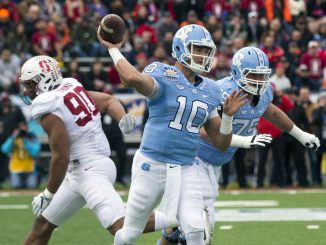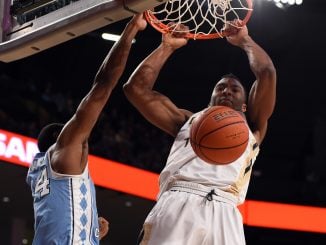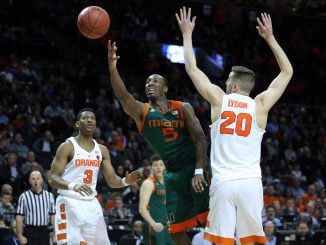
RALEIGH — Every Wednesday, Wake Forest practices the two-minute drill. They’ve followed that schedule since Dave Clawson took over as coach. Whether it’s preseason or regular season, every Wednesday, the offense is given the game situation — score, time remaining and timeouts left — and told to win the game.
“The defense wins more often than the offense,” said tight end Jack Freudenthal, “which, statistically, is the way it should be, I think.”
One thing is consistent in all those drills — Freudenthal doesn’t get the ball.
“I think I scored in two-minute my freshman year, once,” he said. “Other than that, I normally don’t even get the ball that much. They usually throw outside balls.”
On Thursday night at Carter-Finley Stadium, Wake switched things up. Backup quarterback Jamie Newman found Freudenthal over the middle for a 30-yard touchdown with 30 seconds left in the game and changed the fortunes of two programs.
The play gave Wake its only lead of the night, a 27-24 win over the Wolfpack and renewed hope for a bowl game. It also sent No. 14 NC State reeling, with thoughts of a 10-win regular season and big-time bowl gone.
The game plan:
The 4-5 Deacons have been ravaged by injuries on defense and entered the game against the high-powered NC State offense with very little depth. The Deacs also lost starting quarterback Sam Hartman for the year, and Newman was making his first career start on a short week. That necessitated a diversion from Wake’s usual approach on offense.
“We had to completely change our strategy going into this game,” Clawson said. “We were really banged up. We had a quarterback making his first start on the road in maybe one of the toughest places to play in the conference, and we couldn’t snap the ball 90 times today and win. We intentionally made a decision to play slower and to try to keep the snap count down for our defense.”
Wake’s goal was simple — don’t go down by three scores. Hang around and win it late.
“In basketball terms, it was almost a little bit of a stall,” Clawson said. “We tried to bleed it, play it slow. As a coaching staff, the whole process was to get to halftime still in the game, get to the fourth quarter still in the game, and give ourselves at a one-score game. That was the way we were going to have to win tonight, and to say that is one thing. To do it is hard.”
The execution:
The strategy almost worked. Wake’s defense was able to hold State to field goals instead of touchdowns early. Wake trailed by 10 at half and continued to remain within striking distance in the second half. Still, when the Deacs got the ball with 9:16 remaining in the game, they were down 10 — a two-score game, not one.
Newman led the team on a three-minute, nine-play drive that ended with a 19-yard touchdown to Greg Dortch. Then the Demon Deacons stopped State on a fourth-and-3 on Wake’s 20 — the second straight drive in which State turned the ball over on downs in Wake Forest territory. Clawson used all three of the Wake’s timeouts late in that drive to give the Deacs the ball back with 99 seconds left, trailing 23-20.
The drive:
This was what Wednesdays are for. It was time for two-minute.
“We practice it every week,” Freudenthal said, “with different situations — end of half or end of game, different scores, yardage, everything. This time, we had the ball at our own (20-yard line), 1:39 left. We had no timeouts. That’s the situation. So we just played, down after down.”
Newman, running it against a real-life opponent for the first time, kept his cool.
“We worked the situation every Wednesday,” he said. “It’s just like the fruits of your own labor. Just do what you’re coached to do.”
Newman gathered the offense and prepared for the drive.
“In the huddle, we said, ‘We’ve just got to go,’” Freudenthal said. “Jamie’s done it plenty of times. We just did what we wanted to do — completion after completion.”
Newman completed three straight passes to move the Deacs past midfield, then converted a third-and-10 to reach the State 32, just outside of field goal range.
Playing for the tie:
With 37 seconds left, Newman threw to the middle of the field, finding a sliding Sage Surratt for what would have been a short gain that moved Wake into field goal range. Newman would then need to line the offense up and spike the ball to stop the clock, giving the field goal unit time to come onto the field for a kick that would send the game to overtime.
The officials had other ideas, however, ruling that the ball hit the ground before Surratt pulled it in.
“I thought I had it. I thought I got my hand under it,” he said. “But it was an incomplete pass, so it stopped the clock.”
Play was then stopped for a replay review. If it was reversed, and ruled a catch, there would be a 10-second runoff, and the team would have to be ready to execute the field goal plan. If not, they had a second down play to prepare.
“We just had to figure out what play to run if it was complete, and what play to run if not,” Surratt said. “We’d be left with 27 seconds or 37, which would change the whole identity of what we would run. We had to be prepared either situation.”
The ruling came down. The play stood. They had second down, stopped clock, 37 seconds from the 32-yard line.
Again, Clawson and the Deacs decided to throw down the middle to set up a field goal.
The play:
Freudenthal hadn’t had a catch all night and had just 13 on the year. Normally, in two-minute practice, the team tried to throw to the sideline, so receivers could step out of bounds to stop the clock. Now, however, the team wanted to gain yards, run time off the clock to prevent State from driving, then kick the field goal. That meant going over the middle to the tight end.
“The call came to me,” Freudenthal said. “It was a slant return.”
But there was a problem. State sent extra blockers, blitzing with a linebacker and safety to pressure Newman. That changed things. In football lingo, the situation is known as “hot,” and it requires quarterback and receivers to recognize the situation, scrap the original plan and go to the contingency they’ve practiced.
“He knew I was hot on that play,” Newman said. “They brought one more than we could block. He turned around (early).”
“It was a hot route,” Freudenthal said. “I had to break it off quickly.”
Everyone was on the same page, and Freudenthal made the catch.
“He caught a great ball,” Newman said.
Freudenthal was at the 27-yard line. The clock was running, and he was still on his feet.
The score:
Fellow receiver Alex Bachman’s route brought him into the area, a happy accident that resulted from everyone switching to hot routes.
“Normally, he runs a slant or a hitch deep,” Freudenthal said.
Instead, Bachman threw a hellacious block, taking out NC State nickelback Stephen Griffin, who had been covering him, and safety Jairus Morehead, who was running up to hit Freudenthal.
“I caught it, and Bach came across,” Freudenthal said. “It was a heads-up play on that block. Otherwise, I would’ve probably gotten tackled by the safety.”
Instead, the only person in the vicinity still standing was wearing zebra stripes, not a State jersey.
“I was wide open,” he said. “I was surprised I was that open. … I actually had to avoid the ref. Then nobody was around me. I just took off.”
Newman didn’t see the block. Wolfpack safety Tim Kidd-Glass was the extra pass rusher Wake didn’t have anyone to block. He’d hit Newman just as the quarterback released the ball.
“I was on the ground,” he said.
He reached the end zone. After trailing for the last 52 minutes and 12 seconds, improbably, Wake had the lead, 27-23.
“It was awesome,” Freudenthal said.
The aftermath:
From his back, Newman saw the end of the play.
“I could see Jack from the ground, going into the end zone and everybody going crazy on the sideline,” Newman said.
Thirty-two yards downfield, Freudenthal wasn’t sure what happened. The plan all along had been to catch, spike and kick for the tie.
“I thought we were going for a field goal,” Freudenthal said. “I was thinking it was third down. We had to kick.”
Instead, he’d taken it all the way and changed the plan dramatically.
“I didn’t know what to do with myself,” he said. “I turned around, and the offensive linemen were running down to the end zone. Normally, they don’t do that, but they were hauling butt toward me.”
That’s because, in the original scenario, they had to be in position to line up for the spike to stop the clock — and they didn’t have confidence that Freudenthal could make it all the way to the end zone.
“I was kind of slow,” he admitted. “I was getting (teased) in the locker room. They said they thought I was going to get hawked (run down from behind by a defender). So that’s why they were running down so fast.”
State still had half a minute to mount a last-ditch drive. So the Wake celebration was somewhat controlled.
“We couldn’t go too crazy,” Freudenthal said. “But I lost my mind.”
Freudenthal was mobbed in the end zone. Newman pulled himself to his feet and was met by reserve running back Christian Beal-Smith, who was the first onto the field to congratulate him. Center Ryan Anderson was next to find him.
“Ryan texted me earlier in the week when Sam got hurt and said this could be a big opportunity for me,” he said.
Sure enough, when the opportunity presented itself, everyone on the field was prepared for the situation.



